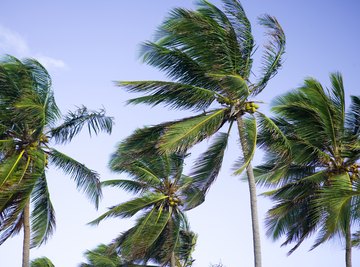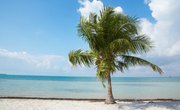
All air movements have their roots in pressure differentials in the atmosphere, called pressure gradients. Systematic differences in the Earth's land temperature affect air pressure, and significant patterns of pressure that persist over time are called pressure belts, or wind belts. Wind belts depend on temperature, so temperature changes can move the belts and also change wind patterns.
Solar Heating
The heat from the sun is strongest at the equator, where solar rays are more intense. This means that the land and ocean surface near the equator tends to be warmer than elsewhere. Other factors lead to differences in surface temperature, such as the geography of the land, and oceans tend to be cooler and more stable in temperature than land. The end result is that there are large, systematic imbalances in surface temperatures on Earth in addition to smaller, local ones.
Pressure Gradients
Surface temperatures affect the temperature of the air above them. Because hotter air is less dense, it tends to rise, while the reverse is true for cool air -- it is more dense and tends to sink. Rising warm air creates low pressure, and sinking cool air creates high pressure. The difference in pressure between any two points in the atmosphere is called the pressure gradient. Because air moves from high pressure to low pressure, pressure gradients create wind by inducing rapid air movements to from high to low pressure.
Pressure Belts
Some air movements are the result of the systematic pressure gradients that arise from latitudinal changes in the Earth's surface temperature. One notable example is the Hadley Cell, a movement of warm air from the tropics that rises, flows toward the poles and then cools and sinks at around 30 degrees north and south of the equator. This movement creates belts of low pressure in the tropics and high pressure in the temperate zone where the air sinks.
Shifting
Because both small winds and larger pressure belts are driven by temperature differentials, changes in temperature at the surface can alter them. For example, ENSO (southern oscillation) events, such as El Nino and La Nina, include unseasonal alterations in ocean temperature that can magnify or decrease the strength of wind belts across the globe. Similarly, when centers of low pressure or high pressure move through an area, they can alter the flow of local wind and even create storms. Tropical cyclones come from low pressure zones in the tropics, and their powerful winds are some of the strongest on the planet.
References
About the Author
Andrew Gellert is a graduate student who has written science, business, finance and economics articles for four years. He was also the editor of his own section of his college's newspaper, "The Cowl," and has published in his undergraduate economics department's newsletter.
Photo Credits
Photos.com/Photos.com/Getty Images
